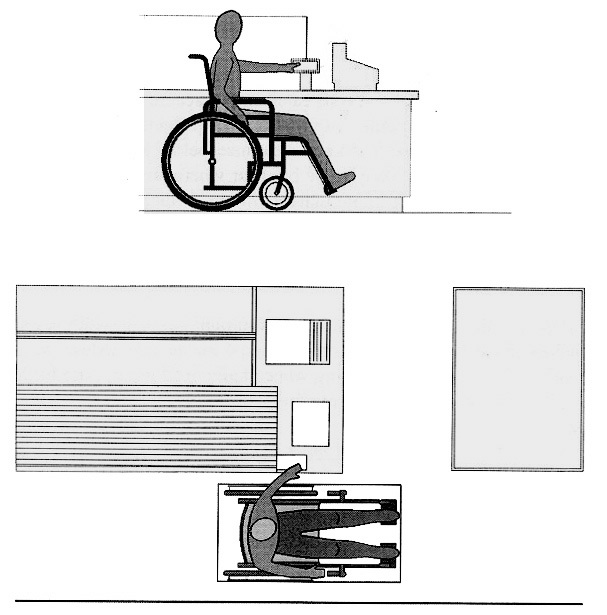Business and Mercantile [7]
Sales Counters [7.2(1)]
In providing access to each "type" it is necessary to consider counters where only certain transactions can be made such as refunds for example, or counters that exclusively serve specific departments or areas of a sales floor exclusively. Recommendation:Travel distances between counters and facility size should be considered where not all counters are accessible. (ADAAG does not specify maximum travel distances).
Other Counters/ Teller Windows [7.2(2)]
Alternatives to 36-inch high counters (lowered portions, folding shelves) are recognized since other design considerations (security, use by standees) may make a higher surface preferable. These alternatives provide an accessible writing surface at counters and windows used for banking, registration, payment, and other purposes. Where multiple teller windows or service areas are provided, such as in bank lobbies, consider access to each one. This eliminates operational considerations for convenient access where single queues form or where only a portion of windows or stations are staffed. At counters designed mainly for handing materials back and forth where the need for a writing surface by customers is unlikely (concierge desks, deli counters, etc.), pass-through space alongside counters can suffice. Fixed elements for public use, such as service buzzers and ticket number dispensers, need to be within accessible reach ranges and on an accessible route.
Sales and Service Counters, Teller Windows, Information Counters [7.2]
ADAAG generally specifies accessible counter heights up to 34 inches [4.32] but allows a height up to 36 inches for counters and service windows in business and mercantile occupancies because public use is limited to brief activities, such as writing a check, signing a receipt, or passing merchandise over the counter.
Check-Out Aisles [7.3]
Access is required based on facility size and the number of check-outs of each design. For facilities with less than 5,000 square feet of selling space, at least one check-out aisle must be accessible.
| Facilities with at least 5,000 sq ft of selling space | |
| Total of Each Design* | Minimum Accessible of Each Design |
| 1‒4 | 1 |
| 5‒8 | 2 |
| 9‒15 | 3 |
| 0ver 15 | 3 (+ 20% of total above 15) |
| *e.g. belt length or no belt, express or cash only, ect. | |
Clear passage must be at least 36 inches wide continuously and 32 inches at a point (24 inch maximum distance). Access can be provided at aisles shared between two check-outs. Access is also necessary at aisles used for exit only (but not check-out). Transaction machines and writing shelves located at accessible aisles should be within reach and usable from wheelchairs. Operable controls, including card swipes, must be with maximum reach heights (54 inches for a side reach, 48 inches for a forward reach). Writing surfaces must be 36 inches maximum from the floor. Recommendations: Adjustable features, such as shelves that can rotate out and machines that can be adjusted for optimum viewing from standing and seated positions will enhance access for the widest range of users. Consider that the standard eye level range of an adult seated in a wheelchair is 43 to 51 inches from the floor.

Security Bollards [7.4] and Security Devices
Bollards and rails used to keep shopping carts on the premises must allow an accessible clear passage (32 inches wide minimum) along at least one route for entry and exit. Alternative entries and accessible gates [4.13.3] can be used as long as they are not less convenient than other routes. For example, gates allowing wheelchair access cannot be locked or alarmed during times when the general public has unhindered access to the facility.
Inventory Control Devices
It is important that inventory control or security devices not obstruct required maneuvering clearances at doors. A minimum 12 inch clearance is required on the push side of swinging doors when the door has both a closer and a latch. This clearance is often useful at exterior doors without latches in countering the force of closers and wind resistance. When doors are automated, maneuvering space is not required.

User Comments/Questions
Add Comment/Question